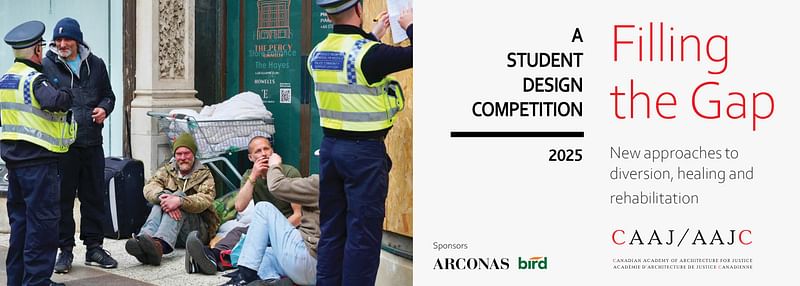Filling the Gap: Designing for new approaches to diversion, healing and rehabilitation
Register/Submit Deadline: Monday, Jun 30, 202511:59 PMEDT
Related
Please follow the link to the Canadian Academy of Architecture website for more information
Filling the Gap: Designing for new approaches to diversion, healing and rehabilitation
Present day societies are facing a wide variety of crises, ranging from the influx of highly addictive drugs to climate change, war, poverty, discrimination, homelessness, the suppression of Indigenous culture, as well as an increasing need for mental health care and support facilities. This in turn is leading some marginalized and struggling members of society towards anti-social behaviour and crime.
While they are often on the frontline of these situations, traditional justice institutions such as police stations, courthouses, and custodial facilities are not always designed to respond effectively to these challenges facing society. As a result, many affected people are falling through the gaps.
Various formal and informal strategies are emerging to address this shortfall, from tent cities and squatter villages to transitional housing, safe injection sites, Indigenous community centres, organizations providing access to social and mental health services, substance abuse programs, crisis centres, and diversion programs for certain criminal charges. These new typologies seek to avoid institutionalization of the individuals involved and instead try to set them on a path to healing, recovery and rehabilitation.
The Challenge
The Canadian Academy of Architecture for Justice (CAAJ) invites architecture students to speculate on these issues in a design competition for a new community-oriented building that helps to fill a gap. This involves the selection of a site in a community of the competitor’s choice, identification of the specific crisis (or crises) being addressed, and the development of an architectural or urban design solution. Design submissions will be evaluated by a jury of justice experts, architects and industry professionals. Participants are highly encouraged to explore a wide spectrum of architectural responses from functional and practical at one end to philosophical and social at the other, including ways in which the building integrates into the community, and acts as a catalyst for building positive relationships with the community it serves.
Design Parameters
- A community-oriented justice facility that includes program elements that are seen as contributing to help solve the specific crisis that the competitor is addressing, such as health and/or social services, transitional housing, library, educational facility, place of worship, etc.
- A site located in a community of the competitor’s choice
- New, adaptive re-use and/or additions to existing buildings are acceptable, as well as other architectural interventions


Share
0 Comments
Comment as :